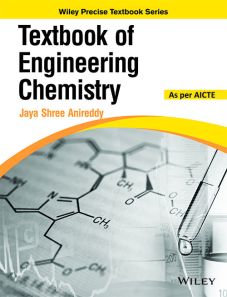Textbook of Engineering Chemistry: As per AICTE
ISBN: 9788126576326
460 pages
For more information write to us at: acadmktg@wiley.com

Description
The objective of textbook of Engineering Chemistry is to build a sound foundation in fundamentals of chemistry and an interface of theoretical concepts with their industrial/engineering applications. This book is designed as an introductory course in Engineering Chemistry with complete coverage of topics and is in accordance with the latest syllabus of AICTE. It aims to impart students an in-depth knowledge of various aspects of chemistry as applied to engineering with a special focus to JNTUH syllabus.
Contents
Preface to this Edition
About the Author
1. Molecular Structure and Theories of Chemical Bonding
1.1 Ionic Bond
1.2 Covalent Bond
1.3 Coordinate or Dative Bond
1.4 Quantum Theory of Chemical Bonding
1.5 Valence Bond Theory
1.6 Molecular Orbital Theory
1.7 Theories for Bonding in Coordination Compounds
1.8 Crystal Field Theory
1.9 Coordination Number and Geometry
1.10 Metallic Bond
2 Water and Its Treatment
2.1 Sources of Water
2.2 Impurities in Water
2.3 Hardness of Water
2.4 Determination of Hardness of Water
2.5 Disadvantages of Hard Water
2.6 Alkalinity of Water
2.7 Analysis of Water
2.8 Water Quality Parameters
2.9 Municipal Water
2.10 Treatment of Water for Domestic Purposes
2.11 Boiler Feed Water
3. Electrochemistry and Corrosion
3.1 Electrical Conductance
3.2 Electrochemical Cells
3.3 Electrode Potential
3.4 Galvanic Cells
3.5 Nernst Equation
3.6 Measurement of EMF of the Cell
3.7 Reference Electrodes
3.8 Electrochemical Series
3.9 Types of Electrodes
3.10 Glass Electrode
3.11 Quinhydrone Electrode
3.12 Batteries
3.13 Classical Batteries
3.14 Modern Batteries
3.15 Fuel Cells
3.16 Corrosion in Metals and Alloys
3.17 Corrosion Cell
3.18 Theories of Corrosion
3.19 Types of Electrochemical Corrosion
3.20 Other Types of Corrosion
3.21 Factors Influencing Rate of Corrosion
3.22 Corrosion Control Methods
3.23 Protective Coatings
3.24 Metal Finishing
3.25 Electroplating Process
3.26 Surface Preparation for Coating
3.27 Electroplating of Chromium and Silver
3.28 Electroless Plating
4. Stereochemistry, Reaction Mechanism and Synthesis Drug Molecules
4.1 Isomerism
4.2 Three-Dimensional Representation of Structures
4.3 Newman Projections
4.3 Chirality and Optical Activity
4.4 Optical Isomerism
4.5 Configuration
4.6 Geometrical Isomerism
4.7 Conformational Isomerism
4.8 Bonding in Organic Molecules
4.9 Electronic Displacement Effects in Organic Molecules
4.10 Reactive Intermediates
4.11 Attacking Reagents in an Organic Reaction
4.12 Types of Organic Reactions
4.13 Substitution Reactions
4.14 Addition Reactions
4.15 Elimination Reactions
4.16 Oxidation Reactions
4.17 Reduction Reactions of Carbonyl Compounds
4.18 Hydroboration of Olefins
4.19 Paracetamol
4.20 Aspirin
5. Spectroscopic Techniques and Applications
5.1 Electromagnetic Radiation
5.2 Molecular Spectroscopy
5.3 Basic Spectroscopy Instrumentation
5.4 Infrared Spectroscopy
5.5 NMR Spectroscopy
5.6 UV–Visible Spectroscopy
Review Questions
Numerical Problems
Answers
Experiments

